
Werewolves of Richard Corben
Draws with Wolves
Written by Leena Peltonen (© 1992 Leena Peltonen)
Translated by SidSid Keränen (© 2002 SidSid Keränen)
Appears here with permission of author.
Appeared first time in Finnish Comic Society's Sarjainfo #74 (1/1992) in Finnish as "Richard Corbenin ihmissusisarjat, Piirtää susien kanssa". ![]()

Werewolf, a man becaming a wolf, as the theme of the story is as old as the tradition of the narrative stories. In different variations curse, witchcraft or alike transforms a human being to body of wolf with a more or less beastie mind, or the spirit of the story has a medical psychosis called lycanthropy, a kind of insanity in which the victim imagines himself to be a wolf, or the form of wolf is just symbolic frame for released bloodthirsty instincts out of humanity.
Werewolves is the theme Richard Corben adores to explore during his career. His most important stories are collected inside of one Catalan Communications album, called as Werewolf (1984). Samples are beautiful and interesting and the album gives a good cross-section of different styles of Mr. Corben. The original printing years of stories are poorly credited in the album. Copyright years cover 1979 to 1984, though for example the famous The Beast of Wolfton was made in 1972. You cannot say is there a chronological or any other order of stories.
The first story is B&W Dead Hill, which sounds like one of the early works. You can identify in this story Mr. Corben's style of enlarged fysical attributes, but there is not yet that unique mixture of caricature, realism and tongue in a cheek humour, that makes reader to hate or love Mr. Corben's works. The plot takes place in a dark medieval and is as simple as that poorly constructed. It variates the most common werewolf story; on a moon rise our furry friend is totally different than we expected.
Next on the album is The Beast of Wolfton, the most Corbenish story. This bloody and cruel openly sexual drama takes place in medieval village called Wolfton, where stygorons has conquered krinders. The son of Krind king wants to revenge his family's death by taking the beasty strong form of moon god Drogim. To slaughter stygorons works well until he faces the most dangerous enemy, the voluptuous Chabitan. The Beast of Wolfton is not only one of the best Mr. Corben's art work, it also has special strong deepness by it's conflict with the nature of both main character. Under the beastie surface krind-warrior is self-sacrifice, innocent, even care. The lock-hair, voluptuous Chabita looks like made for making love, but she's frigid, cruel ja calcuative. You can find the same composition, though less effective, in kind of sequel, The Spirit of the Beast.
Roda and the Wolf is Mr. Corben's very own Little Riding Hood variation. It lays almost completely on pictures, as a matter of fact the minor dialogue in it is the language unknown for me, though it does not disturb any intelligibility. We all know the conversation of big ears and eyes and teeth, but Grimm brothers could blink their eyes as astonished of this very version.
According jolly good old Slemmy the story Lycanklutz is from Warren perioid (in Shokki in Finland). The plot is really sick. Silver is one of the surest ways to get rid of werewolf. To the castle of baron Talbot (!) approaches a visitor, the tradesman Cardiff to propose his invention, the incredible silver-fanged fleas to erase a creature of supernatural horrors on nights of the full moon. They plan a trap to infect frees to werewolf, but mean baron put tradesman as a bait. But the trip for merchant was long and he's got an extra on his sleeves; he peddles with both opponents to increase his own life by selling to werewolf a 30 day flea collar.
Till now all werewolves have roamed in a past. Change... into something comfortable is an urban Halloween story. Sure people do have harrowing mistakes on our werewolf. But the werewolf does mistakes too on a night of masks. This story is also hosted by Slemmy, and it is more experimental on plot and artwork than previos ones.
The end of the album is Fur Trade which takes place in the small colony of New World. Difficult winter has brought hunting wolves on the streets of it. There's a rumor that among beasts there is a shape, not completely beast, not completely man. Reverend understands the real truth and wins the trust of his enemy, learned, witchcraft practising man Flint to fight against werewolf. Third main character on the story is fur trader du Nord, who's on the very werewolf suspects by reverend. From all the werewolf stories by Mr. Corben Fur Trade is the most loyal on traditions. There is several (without too much pointing out) details on werewolf tradition: to be born on Christmas Eve risks to be transformed werewolf, after death of werewolf he will be back his human figure, skinned human belt etc. Rare and surprising reference is fur trader du Nord, who hob-nob with predators. He's like a fade remind of Russian wolf hunters, lukasches, who's got mystic relation with beasts. Fur Trade's artwork is more elecant than Mr. Corben's styles usually, and undeniably it fits on this more reflective morality story.
Mr. Corben's werewolf figures differes from movie world's pointy ear gorilla lookalike all dressed up wolf-man to almost wolfalike occasionally on two feet standing creature. In every cases it is full of destructive strength and primitive horrorness. And it is not only instinct running beast, but there is also a human side. As in Corben himself.
Copyright © 2017 Heart-Attack-Series, Ink!,
Created: March 12, 2017. Modified: December 30, 2018.